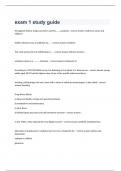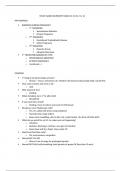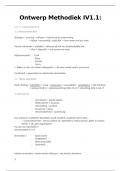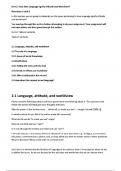Lecture 1
How to define normal (typical) versus abnormal (atypical)?
● Normal as the absence of disorders (they have a positive quality of life and they are able
to function well in everyday life)
○ Abnormal: someone who experiences a negative quality of life (and difficulty
focusing in everyday life)
○ These classification revolve around the 4D’s:
■ 1. Dysfunction (a person not being able to hold a job or having many
problems with social relationships)
■ 2. Distress (person experiences a lot of pain)
■ 3. Deviance (behavior is very different from how other people perceive
the world)
■ 4. Danger (if the behavior maybe increases things like suicidal behaviors)
● Normal: behavior that occurs in the majority of the population
○ It can also be referred to as statistical deviance
○ Normal as a successful adaptation
■ Adaptation: the ability of a person to adapt to his or her environment (the
individual can deal effectively with problems that arise in their everyday
life)
■ Abnormal: poor adaptation to everyday life things
● Disclaimers:
○ In some situations, there is a clear distinction between normal and abnormal
○ There is usually a large gray area (depending on what the situation is)
● Difference between psychopathology and development psychopathology
● Psychopathology: refers to intense, frequent and persistent maladaptive patterns of
emotion, cognition and behavior
● Developmental psychopathology: these maladaptive patterns occur in the context of
typical development
How prevalent is psychopathology?
Prevalence: the proportion of a population with a disorder (number of current cases)
Incidence: the rate at which new cases arise (all new cases in a given time period)
Stigma: it is composed of stereotypes, prejudice and discrimination
Multiple levels: public, personal and self-stigma (or internalized stigma)
Stigma can be fueled by reification (naming the label of the disorder and the explaining are
confused)
1
,Do we reach in the end all the children that need help?
● Of children with problems, only 20 percent receives formal guidance and 35 percent
support through informal services (such as teachers for example)
● Barriers to mental health care:
○ The believe that problems will resolve itself over time
○ Structural problems: such as long waiting lists
● Negative impact is greatest when problems remain untreated for a long time
○ The child may have ADHD symptoms, it is not recognized and this child may
develop bad behavior or start being involved with bad friends
○ Another thing is an adolescent with anxiety problems and when they are not
treated that may lead to depressive symptoms
○ 1 in 5 children have a severe chronic disorder (less likely to finish school and
have more social problems)
○ About 80 percent is treatable
Cultural relativists
● The idea that someone's behavior and practices should be understand based on the
person's personal culture and therefore be interpreted based on that
2
,Chapter 1: introduction
● There is an important distinguishment to be made between typical and atypical behavior
and it is important to make this distinguishment in order to understand if something needs
further attention
● Common descriptions of normality and psychopathology often focus on:
● Stationscal deviance: the infrequency of certain emotions, cognitions and behaviors
● Sociocultural norms: the beliefs and expectations about certain groups about the kind of
behavior that is acceptable
● Mental health perspectives: theoretical or clinically based notions of distress and
dysfunction
Chapter 2: models of child development, psychopathology and treatment
● Dimensional and categorical models
○ Dimensional models of psychopathology: emphasize the ways in which typical
feelings and behaviors gradually become more serious problems which can
intensify then and then become a clinical disorder. As it says in the name, there
are multiple dimensions to the behavior. For example, someone may start drinking
a little bit of alcohol every time they are feeling anxious and this turns into an
alcoholic disorder.
■ With dimensional models, there is no clear distinction between
adjustment and maladjustment. Dimensional models can also be
referred to as continuous or quantitative.
○ Categorical models of psychopathology:
■ With categorical models, there is a clear distinction between what is
normal and what is not
■ Categorical models are also referred to as discontinues or qualitative
Chapter 4: Classification, assessment and diagnosis and intervention
● There are a few assumptions that the DSM 5 makes:
● 1. Disorders are categorical (they reflect clear distinctions between healthy and
disordered adjustments)
● 2. Disorders are associated with “constitutional disfunction” (the idea that the child fails
to display his or her natural function)
● 3. Disorders are endogenous (characteristic of the individual rather than an
individual-environment transaction). This makes sense because if it was something that
had to do with the environment then everyone would be experiencing the same problems
● The DSM used to include only 1 childhood disorder…
● There are 2 commonly identified dimensions of disorder which include: externalizing
dimension and the internalizing dimension
3
, ○ Externalizing: uncontrolled behaviors such as oppositional and aggressive
behaviors that are often directed at others → external and targeted towards other
people
○ Internalizing: overcontrolled behaviors such as anxiety or social isolation that are
often directed toward the self → kept more inwards and targeted at yourself
Two classification concerns: heterogeneity and comorbidity
Heterogeneity: the way children with the same diagnosis or disorder display individual
symptoms and difficulties. We expect there to be the same degree of similarity of course because
all these children are after all diagnosed with the same disorder. However, it is good to keep in
mind that children might for example experience anxiety differently….
Comorbidity: what we often see within psychology, is that multiple disorders coexist together.
Someone with depression might also have a substance use disorder. It is good to keep in mind
that comorbidity occurs for several reasons.
4
How to define normal (typical) versus abnormal (atypical)?
● Normal as the absence of disorders (they have a positive quality of life and they are able
to function well in everyday life)
○ Abnormal: someone who experiences a negative quality of life (and difficulty
focusing in everyday life)
○ These classification revolve around the 4D’s:
■ 1. Dysfunction (a person not being able to hold a job or having many
problems with social relationships)
■ 2. Distress (person experiences a lot of pain)
■ 3. Deviance (behavior is very different from how other people perceive
the world)
■ 4. Danger (if the behavior maybe increases things like suicidal behaviors)
● Normal: behavior that occurs in the majority of the population
○ It can also be referred to as statistical deviance
○ Normal as a successful adaptation
■ Adaptation: the ability of a person to adapt to his or her environment (the
individual can deal effectively with problems that arise in their everyday
life)
■ Abnormal: poor adaptation to everyday life things
● Disclaimers:
○ In some situations, there is a clear distinction between normal and abnormal
○ There is usually a large gray area (depending on what the situation is)
● Difference between psychopathology and development psychopathology
● Psychopathology: refers to intense, frequent and persistent maladaptive patterns of
emotion, cognition and behavior
● Developmental psychopathology: these maladaptive patterns occur in the context of
typical development
How prevalent is psychopathology?
Prevalence: the proportion of a population with a disorder (number of current cases)
Incidence: the rate at which new cases arise (all new cases in a given time period)
Stigma: it is composed of stereotypes, prejudice and discrimination
Multiple levels: public, personal and self-stigma (or internalized stigma)
Stigma can be fueled by reification (naming the label of the disorder and the explaining are
confused)
1
,Do we reach in the end all the children that need help?
● Of children with problems, only 20 percent receives formal guidance and 35 percent
support through informal services (such as teachers for example)
● Barriers to mental health care:
○ The believe that problems will resolve itself over time
○ Structural problems: such as long waiting lists
● Negative impact is greatest when problems remain untreated for a long time
○ The child may have ADHD symptoms, it is not recognized and this child may
develop bad behavior or start being involved with bad friends
○ Another thing is an adolescent with anxiety problems and when they are not
treated that may lead to depressive symptoms
○ 1 in 5 children have a severe chronic disorder (less likely to finish school and
have more social problems)
○ About 80 percent is treatable
Cultural relativists
● The idea that someone's behavior and practices should be understand based on the
person's personal culture and therefore be interpreted based on that
2
,Chapter 1: introduction
● There is an important distinguishment to be made between typical and atypical behavior
and it is important to make this distinguishment in order to understand if something needs
further attention
● Common descriptions of normality and psychopathology often focus on:
● Stationscal deviance: the infrequency of certain emotions, cognitions and behaviors
● Sociocultural norms: the beliefs and expectations about certain groups about the kind of
behavior that is acceptable
● Mental health perspectives: theoretical or clinically based notions of distress and
dysfunction
Chapter 2: models of child development, psychopathology and treatment
● Dimensional and categorical models
○ Dimensional models of psychopathology: emphasize the ways in which typical
feelings and behaviors gradually become more serious problems which can
intensify then and then become a clinical disorder. As it says in the name, there
are multiple dimensions to the behavior. For example, someone may start drinking
a little bit of alcohol every time they are feeling anxious and this turns into an
alcoholic disorder.
■ With dimensional models, there is no clear distinction between
adjustment and maladjustment. Dimensional models can also be
referred to as continuous or quantitative.
○ Categorical models of psychopathology:
■ With categorical models, there is a clear distinction between what is
normal and what is not
■ Categorical models are also referred to as discontinues or qualitative
Chapter 4: Classification, assessment and diagnosis and intervention
● There are a few assumptions that the DSM 5 makes:
● 1. Disorders are categorical (they reflect clear distinctions between healthy and
disordered adjustments)
● 2. Disorders are associated with “constitutional disfunction” (the idea that the child fails
to display his or her natural function)
● 3. Disorders are endogenous (characteristic of the individual rather than an
individual-environment transaction). This makes sense because if it was something that
had to do with the environment then everyone would be experiencing the same problems
● The DSM used to include only 1 childhood disorder…
● There are 2 commonly identified dimensions of disorder which include: externalizing
dimension and the internalizing dimension
3
, ○ Externalizing: uncontrolled behaviors such as oppositional and aggressive
behaviors that are often directed at others → external and targeted towards other
people
○ Internalizing: overcontrolled behaviors such as anxiety or social isolation that are
often directed toward the self → kept more inwards and targeted at yourself
Two classification concerns: heterogeneity and comorbidity
Heterogeneity: the way children with the same diagnosis or disorder display individual
symptoms and difficulties. We expect there to be the same degree of similarity of course because
all these children are after all diagnosed with the same disorder. However, it is good to keep in
mind that children might for example experience anxiety differently….
Comorbidity: what we often see within psychology, is that multiple disorders coexist together.
Someone with depression might also have a substance use disorder. It is good to keep in mind
that comorbidity occurs for several reasons.
4












